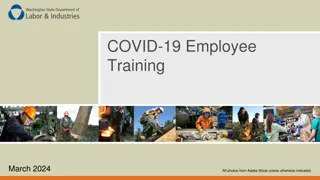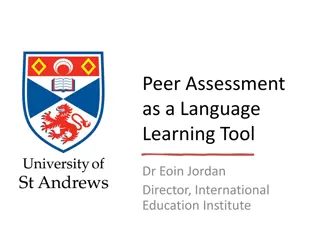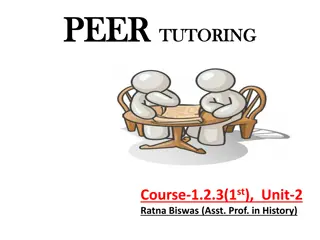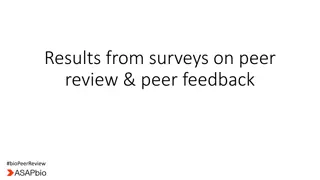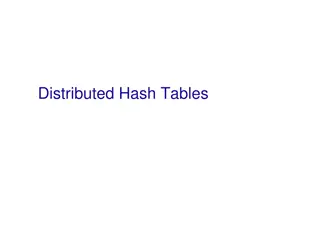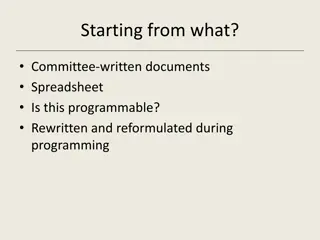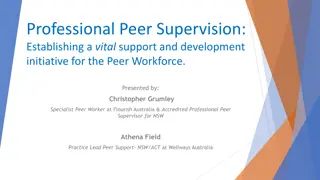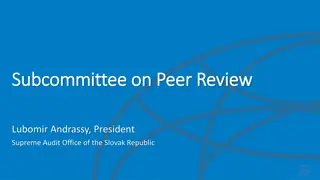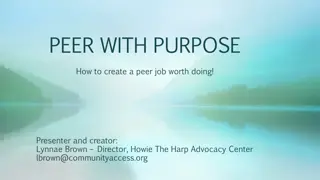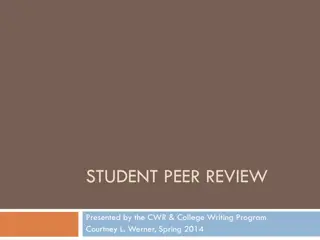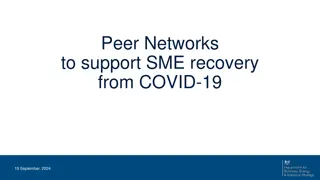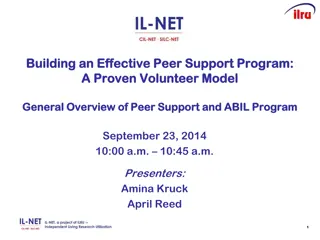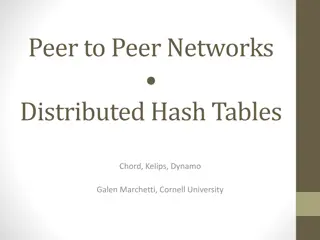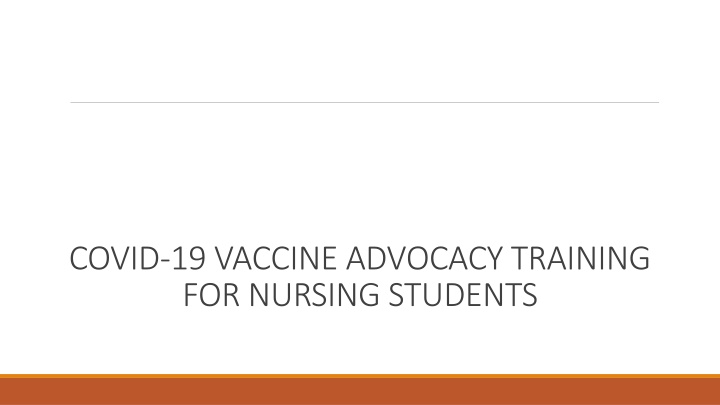
COVID-19 Vaccine Advocacy and Training for Nursing Students
Join our training program to learn about COVID-19 facts, vaccination advocacy, and preventive measures. Understand the importance of immunization in increasing awareness and uptake rate. Explore details about COVID-19, preventive measures, vaccines, and emergency use listings. Gain valuable insights to become a knowledgeable advocate for vaccination among children in Uganda.
Download Presentation

Please find below an Image/Link to download the presentation.
The content on the website is provided AS IS for your information and personal use only. It may not be sold, licensed, or shared on other websites without obtaining consent from the author. If you encounter any issues during the download, it is possible that the publisher has removed the file from their server.
You are allowed to download the files provided on this website for personal or commercial use, subject to the condition that they are used lawfully. All files are the property of their respective owners.
The content on the website is provided AS IS for your information and personal use only. It may not be sold, licensed, or shared on other websites without obtaining consent from the author.
E N D
Presentation Transcript
COVID-19 VACCINE ADVOCACY TRAINING FOR NURSING STUDENTS
OVER ALL GOAL OVER ALL GOAL To increase the understanding as well as awareness of the importance and value of immunization vaccine up-take to at least 90% of all children aged 10 years and above in the western region of Uganda through peer-to-peer awareness creation.
LEARNING OBJECTIVES LEARNING OBJECTIVES By the end of this training, you should be able to: Explain the facts about COVID-19 Demonstrate effective and individualized communications about vaccination, including covid-19 vaccination Outline the importance and justifications for the vaccination of children
FACTS ABOUT COVID FACTS ABOUT COVID- -19 19 This is an infectious respiratory disease caused by corona virus. WHO learned about this virus from the first cases in Wuhan city in China in December 2019. Hence the name COVID-19. Mode of spread is through droplets. Symptoms may include Fever, constantly High Temperature beyond 37 degrees Celsius, Cough, Chest pain, Difficulty in Breathing, General body weakness, Loss of Appetite, Taste and Smell and or Red Eyes.
PREVENTIVE MEASURES PREVENTIVE MEASURES Prevention is by observing the SoPs to the dot, including; Get vaccinated when your turn comes. Wear a face mask covering your nose and mouth while in public. Maintain at least 2 meters (6 feet) distance between yourself and another person. Regularly wash your hands with soap and running water or use an alcohol based hand sanitizer. Avoid public gatherings and crowds. Avoid hand shaking and hugging. All countries have embraced Vaccination as a reliable means of protection against COVID-19.
COVID COVID- -19 VACCINE 19 VACCINE A COVID-19 vaccine is intended to provide acquired immunity against severe disease caused by SARS-CoV-2, the virus that causes COVID-19. COVID-19 vaccines are all designed to teach the body s immune system to recognize and fight the virus that causes COVID-19. There are several vaccines that have undergone clinical trials to determine their effectiveness and safety for human use.
VACCINES Emergency Use Listing (EUL) VACCINES Emergency Use Listing (EUL) AstraZeneca vaccine Pfizer Vaccine Moderna Vaccine Johnson and Johnson Vaccine Sinovac-CoronaVac
VACCINE DOSAGE VACCINE DOSAGE It is important to note that each type of vaccine has its own schedule for one to be fully vaccinated. It is as follows: AstraZeneca Vaccine: Each individual must receive 2 doses given 12 weeks apart. Pfizer Vaccine: Each individual must receive 2 doses given 4 weeks apart. Moderna Vaccine: Each individual must receive 2 doses given 4 weeks apart Johnson & Johnson: It is a single dose vaccine. Sinopharm: Each individual must receive two doses given 4 weeks apart Sinovac: Each individual must receive two doses given 4 weeks apart
THE CONCEPT OF COMMUNICATION THE CONCEPT OF COMMUNICATION Communication entails: Expression, Interpretation and Reaction to messages The art & technique of using words and visuals effectively to share information or ideas through print and electronic media; interpersonal (face to face) Interpersonal communication (IPC) a process by which two or more people share information, ideas, and feelings, includes verbal and non-verbal interaction Empathy the ability to understand and share the feelings of another Empathy helps us to treat people with respect and kindness, regardless of their background, social position or attitude. This helps a communicator to respond to client s questions and concerns about the topic of discussion. Showing empathy makes clients more likely to feel comfortable raising questions or concerns.
Techniques for effective communication Before session: Set aside time to give personal attention On arrival: Welcome warmly and praise for coming In session: Encourage expression of ideas and feelings In session: Listen actively to show interest and respect In session: Acknowledge concerns with empathy In session: Ask questions to check understanding End of session: Summarize and request commitment to vaccinate
Communication about covid Communication about covid- -19 vaccination vaccination 19 Purpose of communication in the context of COVID aims at:- Generating demand for COVID-19 vaccine and encourage uptake of vaccines by eligible population Build trust and confidence in vaccination advocacy Address public concerns regarding vaccine hesitancy and mistrust Encourage people to continue behaviors to prevent COVID-19 infection, even after vaccination IPC is more persuasive for addressing a strongly held practice, attitude or belief by the health providers
Key points to note when communicating about COVID-19 vaccination Health workers play important roles in building community trust about the COVID-19 vaccine. Hence, a health worker must: Have correct and up to date information on the vaccine Use empathy. Put yourself in students position to better understand and respond to their challenges and concerns about the COVID-19 vaccine. Demonstrate caring and respect to students to foster trust and increase uptake of COVID-19 vaccination. Tailor your communication approaches and messages to target groups and levels of demand for COVID-19 vaccine.
Understanding and responding to vaccine hesitancy What is vaccine hesitancy and what should I do? Meaning of vaccine hesitancy Vaccine hesitancy refers to delay in acceptance or refusal of vaccination despite availability of vaccination services (WHO) For additional information: see https://ipc.unicef.org Communicating about Vaccine Safety: Guidelines to help health workers communicate with parents, caregivers, and patients. Washington, D.C.: Pan American Health Organization; 2020. Hesitancy There are many factors that influence people s decision to vaccinate. These include: Attitude of vaccinators Perceptions of what society and our environment expect us to do Perceptions of what others do Norms, customs and barriers to vaccination access The need to devote resources, time or effort to getting vaccinated, The existence of administrative barriers, e.g. opening hours of the vaccination center. Accept all vaccines Accept but unsure Accept some delay and refuse some Refuse but unsure Refuse all vaccines Focus on their concerns: Show respect and do not argue. Point to trusted community members and sources. Discuss to better understand questions and concerns: "Tell me more about that." Respond with empathy. Offer positive encouragement : "That is wonderful!"
Understanding and responding to vaccine hesitancy2 Examples of how to respond to hesitancy with empathy: "I know vaccinating will help me, but I am afraid of side-effects." Health worker: I understand that you want to make the best choice for yourself. What side-effects are you concerned about? Hesitancy Accept, but unsure Accept some, delay and refuse some Refuse, but unsure Refuse all vaccine Accept all vaccine "I am not sure what to do. My community leader objects to vaccines." Health worker: "I can see you are questioning vaccines. How do others you know deal with vaccination? What are your concerns?" Focus on their concerns: Show respect and do not argue. Point to trusted community members and sources. Discuss to better understand questions and concerns: "Tell me more about that." Respond with empathy. Offer positive encouragement: "That is wonderful!" Health worker: Social media and websites can spread false information. You can get the latest on COVID-19 vaccines from the source I trust like MoH website and I am also here to answer your questions. "I read rumours about COVID-19 vaccine online. I do not know what to believe.
Communication Approaches CASE SCENARIO: 1 Potential for vaccine acceptance If eligible for COVID-19 vaccine: o Use a presumptive approach: assume they will accept the COVID-19 vaccine. Sarah is a 38-year-old woman at the health facility for her infant's well-baby care visit. State that they will receive the vaccine today. Share key messages about the COVID-19 vaccine, benefits, common side-effects, care and follow-up. If you receive consent and there are no questions/concerns, proceed with vaccination. If there are questions or concerns, listen and respond with empathy. Use medical evidence or stories to convey vaccine safety, effectiveness, and need. Always be respectful when talking to people. Sarah has diabetes and is overweight. She does not ask about the COVID-19 vaccine. Sarah always brings her baby for health visits and accepts routine vaccines. Is Sarah eligible as a member of a priority group? What would you say to sarah?
Communication Approaches CASE SCENARIO: 2 If eligible for COVID-19 vaccine: o Use a participatory approach: identify and address misinformation/rumors; help them to understand vaccination importance/need. Ask questions to discover misinformation. Share facts and stories to debunk myths & respond to concerns. Acknowledge risks and benefits of COVID-19 vaccine. Ask about vaccine perceptions and preferences; listen and respond with empathy. o If you receive consent and there are no questions or concerns, proceed with vaccination. o If a person remains hesitant, be respectful and provide information to take home; encourage to consider vaccination. Always avoid forcing anyone to be vaccinated. Hesitant due to misinformation Janat is a 25-year-old female who arrives at the health facility for a family planning visit. She works as a Nurse in a high-risk area but has not received a COVID-19 vaccine. When asked, Janat says, "I read it can cause health problems. Is that true? Should I trust the vaccine?" Is Janat eligible as a member of a priority group? What would you say to Janat?
Communication Approaches CASE SCENARIO: 3 | 10 If not eligible for the vaccine: o Recognize and appreciate interest in keeping self and family healthy. o Explain that the current guidelines do not indicate that they should get a COVID-19 vaccine at this time. o Advise her on COVID-19 prevention measures. o If available, provide information on when the vaccine will be available to non-priority groups. Not part of a priority group Maria is a healthy 28-year-old female who brings her infant for a wellness check. She says that while she is at the health facility, she would like to have a COVID-19 vaccine. Why is Maria not eligible for COVID-19 vaccine? What would you say to Maria?
JUSTIFICATION FOR CHILDHOOD JUSTIFICATION FOR CHILDHOOD VACCINATION VACCINATION Implementation of COVID-19 SOPs is still a challenge in schools e.g. Socio-distancing Schools are prone to high transmissibility and hotspots for clustering Suboptimal school surveillance/ scrutiny since there are some day scholars who interact with those out side the school environment on a daily basis. Vaccination of learners was one of the key strategies highlighted for safe opening of schools. Vaccination is the most realistic public health intervention to avoid disruptions in schools Above all, vaccination of children greatly contributes to herd immunity.

